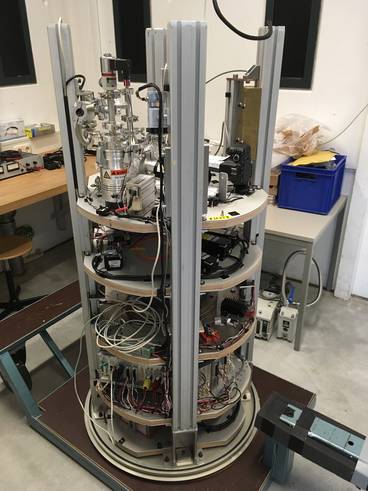Graphene-based spacecraft sail for light-induced propulsion (GrapheneX)

research area: technology tests
experiment title:
Graphene-based spacecraft sail for light-induced propulsion (GrapheneX)
experiment acronym: DYT
funding agency:
ESA (Education) / ZARM
grant number:
Drop Your Thesis! - Program
performing organization:
Quantum Nanoscience Department / Space Engineering Department, TU Delft, The Netherlands
prime investigator:
Prof. Herre van der Zant / Prof. Angelo Cervone
(Santiago J. Cartamil-Bueno, Rocco Gaudenzi, Vera A. E. C. Janssen, Davide Stefani)
experiment objective
abstract
Light from the Sun or a laser beam can be used to transfer momentum to matter and displace low-mass objects. Space agencies have successfully tested the solar sail technology for low-Earth orbit applications, navigation control, and Solar System exploration, with IKAROS being the first demonstration of spacecraft with solar sail as primary propulsion system in 2010. However, the thrust from radiation pressure is too low and requires large areas of thin and low-mass sail material, which makes the engineering difficult, increases the chances of failure, and overall limits the travel velocities. Therefore, new materials with lower mass density, improved optical and mechanical properties, and with new functionalities need to be developed to enhance the light-induced thrust.
Graphene, a one atom thick allotrope of graphite, has been extensively studied in the past decade and the technology is ready to provide high quality large area graphene with properties close to the pristine material: very stiff and strong (Young's modulus of 1 TPa, tensile strength of 130 GPa), highly stretchable (up to 20%), and excellent electrical (350000 cm2 V–1 s–1) and thermal (2500 Wm−1K−1) conductor. The ultimate thinness and minimal mass density of graphene makes it ideal for mechanical systems. On the other hand, graphene is a bad optical reflecting material due to its thinness, although it has considerable optical absorption (2.3%, wavelength independent) that causes a direct momentum transfer from light. Moreover, literature reports an Auger-like effect when illuminating graphene with light that causes an electron emission with a momentum transfer larger than that of pressure radiation and wavelength-dependent.
In this project, we will study the potential use of graphene as light sail. We will measure the light-induced displacement of weightless samples (1-5 mg) consisting on graphene on holey TEM copper grids in high-vacuum and low-gravity. These environmental conditions allow us to isolate them mechanically and thermally, i.e., preventing air flows (natural convection) or advection (forced convection), thermal expansion torques due to clamping, mechanical frictions, and electrostatic/adhesion forces. By using high-power lasers of different wavelengths, together with the results of prior experiments, we will determine the physical mechanism behind the thrust and demonstrate the proof of concept of a graphene light sail.
related publications
- Graphene-based spacecraft sail for light-induced propulsion (GrapheneX), Drop Your Thesis! 2017 - Final Report. ESA Human Spaceflight and Exploration, Erasmus Experiment Archive
experiment campaigns
experiment year: 2017
number of catapult launches: 3
number of drops: 2


 "
"